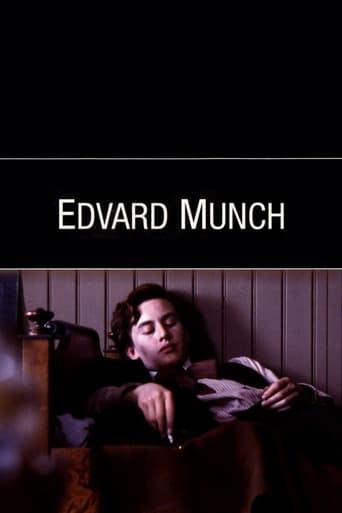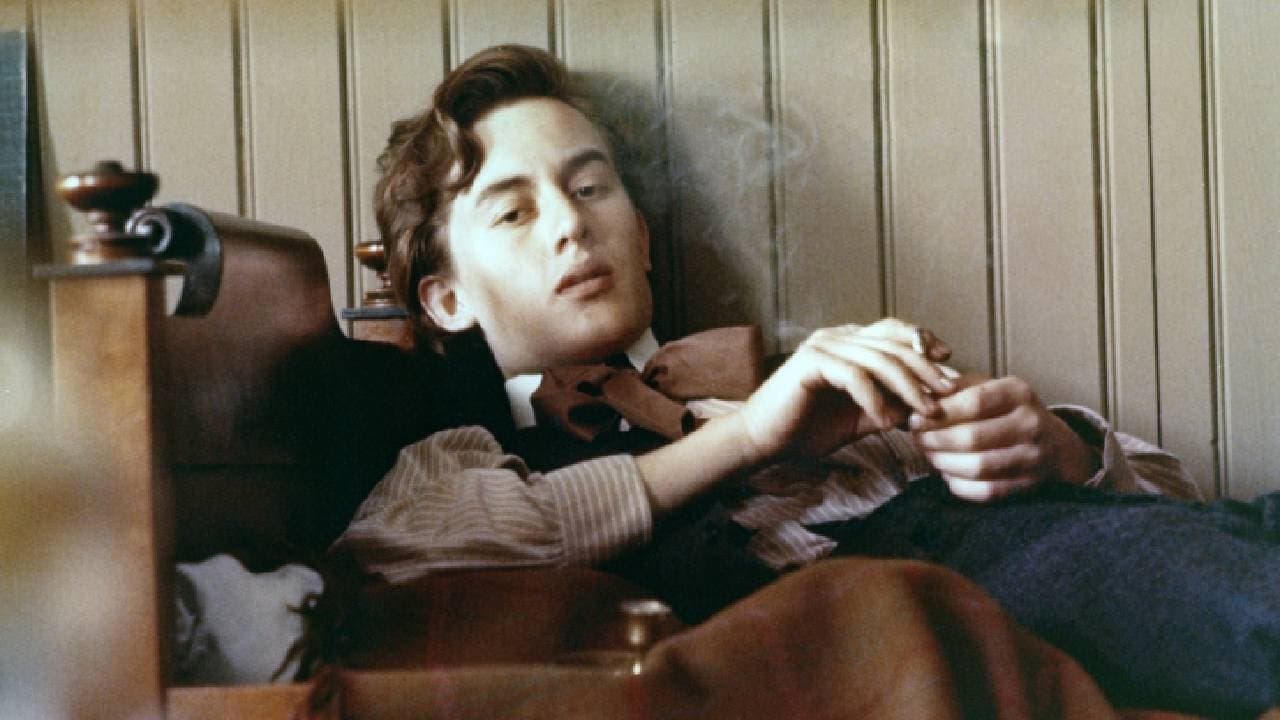Robert J. Maxwell
It's an unusual movie, giving us what I assume to be most of the details of the life and work of Edvard Munch, who was responsible for considerably more than a couple of horror movie satires.It's unusually done. I'm not sure I've seen another quite like it. I was unable to sit through the whole movie because, let's face facts, ars longa, vita brevis. Munch grew up in Kristiania, the capital of Norway at the time, and belonged to a class that I think is called shabby genteel. Religious observances were strict and tuberculosis was ubiquitous. Post-puberty, he joined a local group of intellectuals, "the Bohemians," where art and Marxism were common topics. The first painting he produced was of his sister dressed in black. The narration tells us it "drew scorn" but I don't know why. The painting we see in the film isn't an exact replica of the original but both look pretty good to me. (I speak to you as your art expert. Fee: 1 kr.) It reminded me of Bergman's "Scenes From a Marriage." It's really slow. The growing up is slow. The bedding of Mrs. Hager seems to take as long as the Old Stone Age. There are many choker close ups of ordinary faces, mostly just glancing at one another or, sometimes, the camera. Little attention is paid to the fourth wall. Geir Westby, who plays Munch, bears a remarkable resemblance to the model. He has a sweet, shy face with lips that are a little too full. The other actors fit the roles and they're all quite good. Westby in particular does a good job with a demanding part.I found it a little hard to follow. The narration doesn't always match was we're seeing on screen. There are time shifts back and forth. There's a good deal of attention paid to kissing on the neck, a practice that evidently appealed to Munch and was to generate all those etching of vampires. As a matter of fact, I have a postcard of one of those etchings tacked on my wall as we speak. I'm very proud of it. It was stolen from the National Gallery in Washington.Now, if you think because of that last peregrination about a postcard, that I'm confusing you, wait until you watch this movie. And remember, let us not judge others too harshly. Those with peccadilloes should not throw stones.
tomgillespie2002
Since the mid-1950's the films of Peter Watkins have utilised a mix of documentary and fiction techniques to question these forms of media construct. From the historical portrayals of real, or imagined "realities" (Colluden (1964), The War Game (1965)), to science fiction dystopian visions of political systems (The Gladiators (1969), Punishment Park (1971)), Watkins has placed his cinematic eye within dramatised verite settings, refusing to conform to fiction narrative structures and the normative styles of documentary cinema. In Watkins' anachronistic cinema the characters (whether fictional or historical figures) are photographed as if the action is actually happening, and he breaks conventions further by interviewing characters, filming them in the talking head format, which eliminates the fourth wall in fiction cinema and television, and involves the viewer with the formal realities of detail. Watkins states on his website (pwatkins.mnsi.net) that Edvard Munch is his most personal film. It is certainly his most emotionally engaging, one that is not necessarily as political or prescient as previous films, but perfectly captures the emotional turmoil and strain that goes into the creative process, and particularly the ways in which events in an artists life effects the evolution of form and style.The eponymous Munch's (played, like all here by amateur actor Geir Westby) life and career is dealt with in the usual Watkins style, focusing largely on the period between 1884 and 1894, a period in which his painting developed into what would become Expressionism. It shows a young man struggling with shyness and emotional immaturity, one that when confronted with rejection from Fru Heiberg (Gro Fraas), a married woman who has affairs with bohemian types (the film constantly reminds us of the historical realities of women in 19th century Norway, who require men to live), Munch becomes jealous and possessive. The film juxtaposes these emotional moments of anguish and the tragedies of Munch family fatalities that struck the young throughout his early life, with the development of Munch's painting style. Watkins shows throughout the actual painting process. Beginning with the breathtaking picture The Sick Child, Watkins shows the anger and psychological torment that went into it. The ways in which Munch attacked to painting with knives or the non-bristle end of the brush, which created a startlingly bleak image, devoid of unnecessary details.Of course, as with anything different within an artistic medium, Munch's stripped down aesthetic was not met with praise initially, and Watkins shows the various vitriolic reactions from the art establishment and critics, both through over-heard conversations in gallery spaces, and the filmed interviews with detractors. During these moments, Munch can be seen skulking on the periphery, further exacerbating his deteriorating psychology, but this imbalance and possible fastidiousness influences his further subversion of the classical painting style - and one that would lead to German Expressionism. Periodically the narrator will place historical facts against the period portrayed, and the film is certainly as much about history (sometimes in relation to contemporary politics), as it is about an artist.The bohemian group that Munch spent time with, headed by anarchist Hans Jaeger, would openly discuss political and social issues. Even women would be part of this group, and along with the formal discussion, the "film crew" interview various female exponents, discussing feminism and the role of the female within society. Placed within this historical context, the present (at least in 1974 when the film was released) was in what appeared to be a new sexual revolution, and the feminist movement was a media convention, but in 19th century Europe, these women see what they are able to achieve living within the constraints of a male dominated society. Whereas prostitution (in the '70's it was pornography) is socially seen as immoral and degrading, these female thinkers see it as motivating, a process of female empowerment. In Edvard Munch the women are self-contained, they are individual and have power over their own lives. But this is not exclusively inclusive of female characters, it is also a film (through its documentary style) that includes the audience.Munch is the best use that I have seen of Watkins' idiosyncratic documentary style, because it is an emotional exploration, as well as a political one. The emotional aspects are embellished by the characters acknowledgement of the viewer. Throughout the film the characters look directly into the camera, addressing the audience with a glance, at times to question their own actions (should we do this?), or by including the audience in the emotional events that are occurring, you always feel included, even when those moments are incredibly voyeuristic. I at times even felt that I should not be privy to this, such was the effect of this connecting barrier. Like much of Watkins' work (and himself as a figure), Edvard Munch has been marginalised. Watkins' criticism of mass media has clearly left him out of main stream publication, and his work (whilst now gaining distribution and serious praise) is difficult to see commercially. Originally made for a Norwegian/Swedish television co-production, the film lost distribution due to the studios refusal to play it. The film did received an international release in a shortened version, but the 221 minute version is now accessible. It sounds exhausting, but the majesty and emotional connection the film presents makes it a beguiling and moving experience, and it is easily the most in depth exploration of the artistic process.www.the-wrath-of-blog.blogspot.com
ursulahemard
Very interesting and innovative new approach of movie-making. A documentary within a biopic: Norwegian actors representing and picturing Munch, Munch's family, friends, fiends and contemporaries (speaking in Norwegian with subtitles) filmed in a journalistic way, whilst a narrator takes us through in English being sometimes Munch himself or sometimes as an instructor. The chronology of the living facts is juxtaposed by the past with a deep insight of Munch's emotional evolution and disturbances. One does learn a lot about the artist and his oeuvres. Don't expect a motion picture with a plot and you must be interested by Munch himself to be able to enjoy this throughly. Keep in mind that it's 3h30 long. Watchable for adolescents.
Jon McNeill
Peter Watkins' Edvard Munch contains artistic innovations in editing and story that surely would have changed the face of how films are made--if only more people had seen it. Through an inspired stream-of-consciousness editing style, Watkins approximates the workings of the mind with greater success than ever before seen on screen. Because of this achievement, Watkins is able to convey, with vivid strokes, the intensity of Munch's emotions, and how they led to his tortured art. It is tragic that this film has not seen larger distribution, just as it is tragic that Watkins' other films are cloistered by the very companies that produce them. But then again, I cannot imagine going to the cineplex and watching a statement of life through art as soaring and original as Edvard Munch. For now, I'll continue to treasure it alone.


 AD
AD



